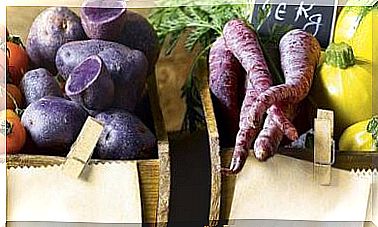The Technique Of Marinating Vegetables: Everything You Need To Know
If you want to change and improve flavors of both vegetables and “vegetable meats”, sign up to marinate them. In this article I explain the keys to do it well.

- What foods can be marinated?
- What ingredients are marinades made with?
- 6 recommendations to marinate well
- Green marinade recipe
- Soy marinade recipe
- Mediterranean marinade recipe
Marinating foods consists of dipping or brushing them with liquid ingredients and spices before cooking to absorb flavors. For meats, acidic or enzymatic means are used to soften it, but it is something that we will not need to do in our case, with 100% vegetable ingredients.
When we marinate food, we obtain ranges of flavors that we cannot obtain in other ways. Instead of cooking them and adding spices and sauces, we’ve infused them into them.
Virtually all cultures have some form of marinade with local ingredients, so we can tailor a ton of flavors to suit our tastes and marinate just about anything. Depending on the ingredients that we put in the marinade we will obtain different results.
- Flavor on the outside and inside. Adding salt makes it easier for the flavored liquid to enter our food by osmosis. Take pickles for example: they don’t just taste salty and sour on the outside, they also taste on the inside. This effect also depends on the composition of the food we use and the time we leave it marinating.
- Aroma in all food. The aromas and flavors of the spices that we use will end up on the surface of our food and will also enter a little (it depends on the food, cauliflower is not the same as eggplant), giving it flavor without the need to add anything else later (if we do not want to). That is, when you marinate, for example, tofu, to cook it you just have to add it to the pan, you don’t need to add more spices, herbs, sauces, etc.
What foods can be marinated?
Almost all foods can be marinated, from fruits to legumes:
- Tofu for example is a classic ingredient that we usually marinate because it has a very neutral flavor, and in this way we give it much more flavor than just cooking it with spices and sauces.
- When we make a fruit salad and let it rest, we are also marinating the fruits, in this case with the flavors that are released into the liquid, and with the flavors of the juices that we add.
- Vegetables such as eggplant, zucchini, squash, broccoli, or cauliflower also benefit from this process. They are super juicy and tasty, especially the eggplant, because it has a spongy texture that absorbs everything we add very well.
- Green leafy vegetables are more delicate and tend to absorb less (they are much finer), but they can also be marinated, especially if we are going to serve them raw.
- Legumes can be marinated once cooked and soak up a lot of flavor. It is a good way to prepare them for example for salads, because that way they will stand out much more than in puree (vegetable patés) or sautéed.
- Cereals in general can also be marinated, but it must be taken into account that they tend to come dry, that they absorb a lot of water and that their texture can become softer when doing so. In the case of rice, for example, it is better to cook it with the marinade (and water) rather than let it rest in it.
What ingredients are marinades made with?
Well that depends a lot on tastes and the region in which we are. As I mentioned before, local and seasonal ingredients are usually used.
- Water is usually used as a base. That is, as we need to submerge the food in the liquid, the container is filled with water after adding spices, herbs, sauces, etc. The more water we add, the less flavor the marinade will have. To avoid having to add too much water, choose containers in which you can put your vegetables or tofu in a single thin layer, so you will need little water to cover everything.
- Yogurt is also used as a base (always use natural vegetable yogurt without flavors and without sugar), sauces (for example soy sauce), vinegars (apple, wine, rice, etc.), broths (vegetable broth) or pasta (tahini, peanut butter, etc).
- Many marinades have acidic ingredients because they are traditionally used to tenderize meat, so in our case, if you don’t want to add acids, you don’t have to. Of course, vinegars provide not only acidity, but also flavor and a form of preservation, so it is not a bad idea to include them.
- In general, they all contain spices and herbs, preferably dry, because that way they hydrate and release aromas to the liquid. There are compounds that are soluble in fats, and they will be more noticeable when we make dense marinades with oils (making an emulsion, if the oil does not stay on top). The spices that we usually have at home serve us perfectly: parsley, thyme, rosemary, paprika, pepper, bay leaf, cloves, ginger, garlic … Choose the ones you like. You can also use other spices like star anise, cinnamon, or cardamom, which are very popular in Indian cuisine.
6 recommendations to marinate well
- When you want to make a dish with marinated ingredients, schedule it for at least the next day. It takes time for the food to absorb the marinade, it is not instant.
- Cut your ingredients (vegetables, tofu, etc.) into medium pieces, do not make them giant or too small. If they are very large, the whole part of the interior will not absorb anything (or almost nothing), and if you make them too small, they may later fall apart when you cook them.
- Normally marinated things are left to rest at room temperature, but if it is hot or if you are using fermented (like yogurt, sauerkraut, etc), it is better to leave them in the fridge.
- One of the mistakes we usually make is to put too little amount of spices and herbs. We usually add the same that we would put to sauté it. Think that those flavors are going to be diluted in the water, so add a little more.
- Add salt both to enhance the flavor and to promote conservation, especially if you are going to marinate for several days.
- It can be cooked with the marinade, you don’t have to throw it away. For example, if you are making a sautéed marinated tofu, you can add a few tablespoons of the marinade before turning off the heat and let it reduce, for more flavor.
- Make your marinades with whatever you have at home. If you need ideas, here are a few.
Green marinade recipe
Green marinade is ideal for tofu, veggie meats, greens
Ingredients:
- Fresh parsley (1 small bunch)
- Fresh coriander (1 small bunch)
- Spring onion or chives (1 spring onion)
- 1 clove of garlic, peeled
- ¼ teaspoon salt
- 2 tablespoons apple cider vinegar or lemon juice
preparation:
- Beat all the ingredients with the mixer.
- To use it, cover your food with this paste, stirring it well, and let it marinate for at least 12 hours in the fridge.
- Do not add water unless it is very necessary (for example, you have a paste that you cannot mix well.
Soy marinade recipe
Soy marinade is great for marinating tofu, veggie meats, cauliflower, zucchini, and eggplant.
Ingredients:
- 150 ml of soy sauce
- 50 ml sesame oil
- 1 teaspoon chives, minced
- 1 spring onion, chopped
- 1 teaspoon minced fresh ginger or 1/4 teaspoon if powdered
- 1 clove garlic
preparation:
- Put the soy sauce with the garlic clove in a mixing bowl or blender and beat.
- While beating, add the sesame oil little by little until an emulsion forms.
- Take it out and add the chives and spring onion and mix.
Mediterranean marinade recipe
The Mediterranean marinade is ideal for marinating any ingredient.
Ingredients for 2 people:
- 1 teaspoon dried parsley
- 2 bay leaves
- ½ teaspoon sweet paprika
- ¼ teaspoon thyme
- 1 sprig of rosemary or 1 teaspoon if dry
- ½ teaspoon oregano
- 1 tablespoon apple cider vinegar
- ¼ teaspoon salt
- Water
preparation:
- Put your already cut ingredients in a container. Top with all the spices, vinegar and salt.
- Fill the container with water, just enough to cover your ingredients, cover it, shake it and leave it in the fridge for at least 12 hours.
- If you can, shake it from time to time (when you remember).









